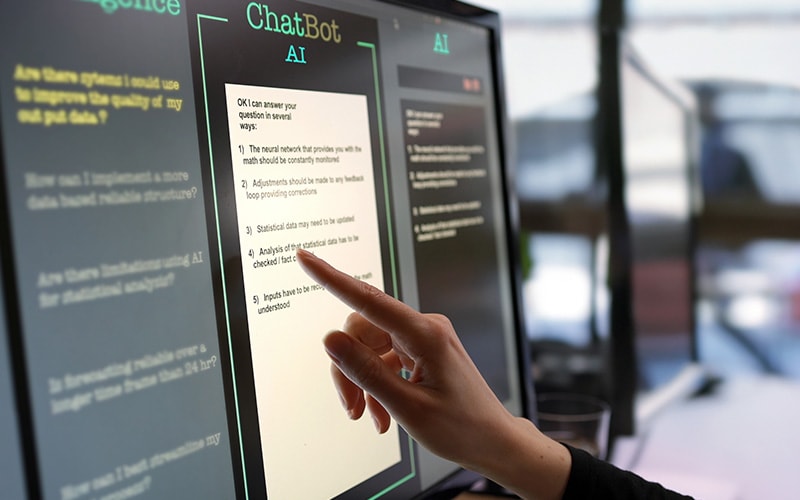Insights
- Successful deployment of AI agents requires organizations to understand the agents’ roles, capabilities, and integration within enterprise business processes across the value chain.
- The sense-plan-act cycle is fundamental to agentic AI architecture, enabling agents to interpret data, plan, and execute tasks autonomously.
- Choosing the right type of AI agent, from simple reactive systems to advanced learning agents, is crucial for handling specific tasks and achieving the full potential of AI systems.
- A well-structured agentic AI system enhances decision-making transparency, adaptability, and collaboration with human teams, aligning strategically with business objectives.
Artificial intelligence (AI) is evolving into more intuitive and independent systems with the advent of agentic AI, which allows for autonomous decision-making and real-time responsiveness. By 2025, many companies will begin exploring agentic AI pilots, with widespread adoption anticipated by 2027. This report delves into the transformative potential of agentic AI, the roles of AI agents, and the strategic importance of understanding agentic architecture for business leaders.
Agentic AI is transforming how businesses automate decision-making and streamline complex workflows. However, simply deploying AI agents does not guarantee success. Agent capabilities vary and do not function in isolation; they operate alongside humans and are embedded within enterprise business processes across the value chain.
As AI capabilities advance, business leaders will develop a deeper understanding of the intricacies at play: the distinct roles of AI agents, the layers of agentic architecture, and the tools and frameworks that facilitate integration into existing IT ecosystems. This will be a strategic imperative, not just a technical curiosity.
This deeper knowledge allows business leaders to make more informed decisions about technology investments, resource allocation, and process optimization — enhancing efficiency and strengthening their competitive advantages. A well-structured agentic system ensures that AI decision-making is transparent, adaptable, collaborative with human teams, and strategically aligned with business objectives.
Understanding types of AI agents
At the core of Agentic AI architecture is the sense-plan-act cycle, where AI agents interpret data from their environment, formulate a plan, and autonomously execute tasks. This architecture establishes the fundamental building blocks required for AI agents to operate effectively, whether as a single agent or multi-agent system. Both approaches leverage machine learning and computational reasoning, but the choice of agent type significantly affects whether the AI system can reach its full potential.
Different agents are required for varying levels of task complexity, ranging from simple reactive systems to highly sophisticated learning agents. Selecting the appropriate agent type ensures it can handle the specific task, whether it involves basic automation or complex decision-making.
Understanding an agent's capabilities helps set realistic expectations about what it can achieve, preventing overreliance on its abilities and potential misuse. Knowing the type of agent allows developers and architects to:
- Select the best algorithms and learning methods.
- Determine appropriate data collection and preparation processes.
- Choose architecture that enables optimal performance and integrates with existing systems.
By aligning the agent type with its intended functionality, organizations can maximize AI performance, efficiency, and reliability while avoiding unnecessary complexity or operational risks.
Reflex-based agents
Reflex-based agents use a predefined set of rules, or reflexes, making them the most basic type. These agents are programmed to perform specific actions whenever certain conditions are met, without requiring advanced reasoning or learning.
In manufacturing, reflex-based agents can play a critical role in quality control. These agents use cameras to capture images of components as they move through the production line. Using predefined criteria, the agents analyze images in real time and instantly flag defects. Their actions are binary, either accepting or rejecting components based solely on the visual input. For example, Intel uses reflex-based agents in its chip manufacturing plants to improve precision and efficiency in quality control.
Model-based reflex agents
Model-based reflex agents are a specialized type of reflex agent that maintains an internal model to track environmental changes. This model is continuously updated as new information arrives, allowing the agent to make decisions based not only on its reflexes but also on past experiences and current state.
A smart irrigation system is a prime example of a model-based reflex agent. Rachio smart sprinklers integrate weather forecasting data and soil moisture models, learning from local weather patterns while considering soil type, plant type, sun exposure, and slope to create predictive, data-driven watering schedules.
Goal-based agents
Goal-based agents integrate an internal model of the world with a defined goal or set of goals. Before acting, they plan and search for action sequences that will help them achieve their objectives. This deliberate, strategic approach makes them more effective than reflex-based or model-based agents.
These agents are widely used in warehouse automation to optimize order fulfillment. In automated fulfillment centers, goal-based agents operate with specific objectives, such as completing an order within a set timeframe. To achieve this, agents plan the most efficient picking routes through the warehouse while coordinating with other robots to prevent conflicts and ensure smooth operations. A notable example is Amazon's Kiva robots, which efficiently manage inventory movement and order fulfillment in the retailer’s automated warehouses.
Utility-based agents
Utility-based agents select the optimal sequence of actions that allow them to reach their goals and maximize utility or reward. Utility is determined by a function that assigns a utility value — a metric that measures the usefulness of an action or how “satisfied” it will make the agent — to each scenario based on fixed criteria.
These agents play a crucial role in portfolio management, particularly in automated trading and investment optimization. Investment firms deploy utility-based agents to navigate the complexities of financial markets, evaluating factors such as risk, return, market conditions, and client preferences. Using sophisticated utility functions, these agents balance competing objectives, such as growth and stability, to make optimized investment decisions. A prime example is BlackRock's Aladdin platform, which leverages utility-based agents to enhance investment management and performance.
Object-centric or “curious” agents
An object-centric, or “curious” agent, focuses on understanding and interacting with individual objects in its environment rather than simply perceiving the overall scene. It prioritizes detailed information about specific objects, their properties, and their relationships with one another to inform decision-making and actions.
These agents are used frequently in the healthcare industry, particularly in radiology departments. Object-centric agents actively analyze medical images, detecting and learning new patterns across various imaging types, such as X-rays, MRIs, and CT scans. By continuously learning from new cases, these agents improve diagnostic accuracy over time. A notable example is Arterys' AI platform, which uses object-centric agents to enhance medical imaging analysis, ultimately supporting better clinical outcomes.
Citizen-centric autonomous agents
Citizen-centric autonomous agents use advanced AI models to independently manage routine personal and professional tasks. These agents analyze user objectives, break them into actionable steps, and execute workflows across applications without manual intervention.
For instance, OpenAI’s Operator agent can autonomously manage email sorting, appointment scheduling, and online purchases by interacting with web interfaces through screenshots and keystroke simulations. Similarly, Google’s Agentspace enables users to automate document processing, such as extracting key details from PDF invoices and populating expense reports in real time. Anthropic’s Claude Computer Use is an AI Agent that is good at autonomously performing desktop tasks while Operator is good at browser-based tasks. By integrating natural language understanding with cross-platform interoperability, these tools allow individuals to delegate repetitive digital tasks.
Figure 1. Each agent type focuses on a different part of the sense-plan-act cycle
Source: Infosys
Building an agentic system
Enterprise systems are inherently deterministic, designed to execute specific, rule-based tasks, even when those tasks involve complex business logic. However, integrating AI agents into these systems introduces an element of nondeterminism. Unlike traditional enterprise software, AI agents plan action sequences dynamically, adapting their behavior as inputs evolve through learning. Despite this adaptability, their actions must remain within the boundaries of standard operating procedures to ensure consistent and reliable outcomes.
For developers and architects, understanding the interaction between deterministic enterprise systems and AI agents is critical when designing enterprise-grade applications. Organizations must carefully evaluate task complexity, computational resources, and operational constraints to develop an effective and scalable AI architecture that balances flexibility with control while ensuring reliable performance.
Agentic AI architecture
When developing agentic AI architecture, organizations must determine the number of agents required and the roles they will play.
Agentic systems follow two fundamental configurations: single-agent and multiagent architectures. Both leverage machine learning models and computational methods to execute the sense-plan-act cycle, enabling intelligent decision-making and automation. By combining established principles with AI advancements, developers can expand the capabilities of agentic systems, unlocking new possibilities for enterprise applications.
The complexity of a task determines whether a single-agent or multiagent architecture is the best approach. Single-agent architecture is ideal for tasks that follow clear, well-defined steps and have minimal tool requirements. In contrast, multiagent architecture is better suited for complex tasks that require collaboration, feedback, and the parallel execution of subtasks. (This report focuses on multiagent architecture.)
After deciding that a multiagent system is needed, the agents must then be classified. The role-based agents are labelled based on their jobs, such as advisor, coder, reviewer, or tester. The interaction model-based reflex agents are categorized by their cooperation with other agents. This could be vertical (leader or servant) or horizontal (peer-to-peer).
Research indicates that multiagent systems are more effective when roles are clearly defined. A leader agent coordinates tasks, while servant agents communicate with both the leader and their peers. Teams with an organized leader complete tasks nearly 10% faster than teams operating without a designated leader.
Agentic architecture layers
The foundation of any agent-based system consists of multiple interdependent layers that work in harmony to enable intelligent behavior. These layers function as a pipeline, transforming raw input into actions while maintaining the agent’s internal state and reasoning capabilities. At the core, the sense-plan-act cycle drives decision-making, while the standard architecture layers ensure the system meets critical enterprise architecture requirements (Figure 2).
Figure 2. Agentic architecture layers and supporting technology
Source: Infosys
Core layers
Perception: functions as the agent's sensory interface with its environment, responsible for processing raw inputs, reducing noise, and extracting relevant features. It converts unstructured data into a structured format, allowing the cognitive layer to process information efficiently. In a robotic system, this layer analyzes camera feeds, sensor data, and environmental readings — transforming them into a structured state representation for further analysis and action.
Cognitive: serves as the agent's brain, handling decision-making, planning, and learning. It manages the agent's internal state, processes information from the perception layer, and determines the most appropriate actions based on its goals and current understanding. Depending on the agent’s complexity, this layer can range from a simple rules-based system to an advanced neural network.
Action: translates decisions from the cognitive layer into activity. It is responsible for validating actions, performing safety checks, and monitoring implementation. This layer ensures that planned actions are feasible and safe before implementation, while also monitoring feedback to evaluate outcomes.
Standard layers
Integration: serves as the connective tissue of the agentic architecture, facilitating seamless communication and data flow between the system’s layers and external systems. It enables real-time data access, manages interoperability, and ensures smooth interactions, enhancing the system’s overall functionality and responsiveness.
Operations: oversees and manages the real-time performance of agentic systems. It monitors system activities, provides feedback mechanisms, and facilitates continuous improvement by optimizing processes based on operational data.
Infrastructure: delivers the computational power and storage required for agents to execute complex tasks efficiently while ensuring high availability, scalability, and reliability.
How to implement agentic AI
The successful implementation of agentic AI systems requires careful selection of agent types, tools, and frameworks that align with their specific capabilities and overall business objectives. As a relatively new and rapidly evolving technology, many companies remain uncertain about how to develop and deploy agentic AI effectively.
Organizations must navigate significant technical complexity to ensure successful execution. Selecting the right tools and frameworks is crucial for an agentic system’s operational success, ensuring scalability, efficiency, and integration with enterprise environments.
There are four broad categories of agentic platforms and frameworks available to enterprises:
- Vertically integrated agentic platforms, with domain and services specific agents delivering services-as-software (Salesforce Agentforce, ServiceNow AI Agents, SAP Joule).
- Cloud provider agentic platforms and frameworks for agent development and management (Amazon Web Services Bedrock, Google Vertex, Microsoft Copilot Studio and AI Foundry SDK).
- Open-source AI agents, frameworks, and tools (LangGraph, CrewAI, AutoGen, MetaGPT).
- Proprietary agentic platforms focused on agentic automation for specific processes and features, (Beam AI, Cognition AI, Kore.ai).
The following section outlines the key capabilities of three widely used agentic AI frameworks that can be used to create custom-built agentic solutions.
Compatibility with agent types
Enterprises should ensure that the selected tools and frameworks align with the specific type of agents being developed, whether reflex-based, model-based, or goal-based. Each agent type has distinct requirements — for example, reflex-based agents require real-time processing, while goal-based agents depend on advanced planning algorithms.
| Framework | Features | Best fit for agent type |
|---|---|---|
| LangGraph | Graph-based workflows, real-time processing, structured data handling, and memory management; can implement cycles and branching logic, enabling agents to manage dynamic tasks effectively | Reflex-based, model-based, utility-based |
| CrewAI | Role-based design, task delegation, multiagent collaboration, advanced memory; integrates well with LangGraph for combinations of different agent types | Goal-based |
| AutoGen | Conversational approach; quick responses; modular design; supports planning | Reflex-based, goal-based |
Scalability
Preferred frameworks scale efficiently as task complexity increases or as the number of agents grows. Multiagent systems often require a robust infrastructure to handle higher workloads and ensure seamless communication among agents.
| Framework | Features |
|---|---|
| LangGraph | Scales effectively with graph nodes and transitions; supports complex workflows and memory systems for handling increased loads; enterprise-ready platform with LangSmith |
| CrewAI | Production grade scalability with NVIDIA NIM integration; ideal for tasks requiring multiple agents to work in parallel |
| AutoGen | Well suited for conversational agents and modular components; tailored for simpler multiagent scenarios; still at experimental stage and not fully production ready |
Integration and interoperability
Tools should enable seamless integration with existing enterprise systems and technologies. They must support standard protocols and APIs, ensuring effective communication between agents and external data sources and services.
| Framework | Features |
|---|---|
| LangGraph | Supports seamless integration with other frameworks by wrapping agents in nodes, allowing for multiagent systems and effective communication with external data sources; access to comprehensive LangChain ecosystem — leading LLM app development platform |
| CrewAI | Built on LangChain, it facilitates easy integration with various tools and supports standard protocols for effective agent communication, including collaboration with LangGraph |
| AutoGen | Modular design allows for integration with multiple tools and services, ensuring agents can communicate through APIs; limited to Microsoft ecosystem |
Flexibility and customization
Frameworks should offer flexibility for customization to meet specific business needs and operational workflows. The ability to modify agent behaviors and integrate new functionalities is essential for adapting to evolving requirements.
| Framework | Features |
|---|---|
| LangGraph | Can tailor solutions to specific needs and manage complex business interactions |
| CrewAI | Provides flexibility through its role-based architecture where developers can create custom agents with defined roles, skills, and behaviors. Its customization capabilities are currently limited to sequential and hierarchical task workflows rather than complex collaborative patterns to solve the problem (which is under development as of early 2025) |
| AutoGen | More suited for conversational model (group chat, reflection) among agents with limited support for complex workflow models |
Support for learning and adaptation
Frameworks with built-in machine learning capabilities are needed to support continuous improvement. This is especially critical for agents that must learn from their environments, adapt their decision-making strategies, and refine their performance over time.
| Framework | Features |
|---|---|
| LangGraph | Supports stateful, multiagent applications with automatic state management and coordination, enabling agents to learn from interactions and adapt strategies dynamically |
| CrewAI | Supports memory functionalities, enabling agents to retain context from previous interactions; allows agents to build on experiences, enhancing adaptability and effectiveness in dynamic environments; can train agents using command line interface (during design time) to learn from human feedback |
| AutoGen | AI agents can collaborate, share information, and solve complex tasks together while learning from each other. Flexible architecture, allowing developers to create specialized agents (e.g. AssistantAgent and UserProxyAgent) that can engage in multiturn conversations, work together, and learn as a result with features like code execution, customizable conversation patterns, and human input integration |
Observability and monitoring
Tools should include observability features to monitor agents and the performance of underlying LLMs or SLMs in real time. Real-time monitoring enables developers to track agent effectiveness, identify bottlenecks, and optimize system performance.
| Framework | Focus | Tools or support |
|---|---|---|
| LangGraph | Graph execution details (node performance, traversal, errors) | LangSmith, Arize Phoenix, and AgentOps |
| CrewAI | Agent task execution, communication, and tool usage | AgentOps and Arize Phoenix |
| AutoGen | Conversation flow, LLM calls, tool usage, agent behavior | AgentOps and Arize Phoenix |
While not all these frameworks provide built-in observability and monitoring capabilities — with LangSmith being an exception — they integrate well with enterprise-ready platforms that support open protocols like OpenTelemetry.
For complex ecosystems utilizing quantized models or SLMs, additional production-grade tools, such as Fiddler AI or Galileo, can further enhance model and data quality monitoring.
| Tool | Purpose | Monitoring features |
|---|---|---|
| AgentOps | Agent testing and debugging |
|
| Arize Phoenix | Retrieval-augmented generation system monitoring |
|
| LangSmith | LangChain development and monitoring |
|
| Fiddler AI | LLM performance monitoring |
|
| Galileo | AI model training performance and data quality |
|
Development community and support
Tools with a strong development community and robust support resources contributes to the successful implementation of complex agentic AI systems. A well-established community provides access to troubleshooting assistance, knowledge sharing, and best practices.
| Framework | Features |
|---|---|
| LangGraph | Strong development community supported by active GitHub repositories; comprehensive documentation; integration with LangSmith for performance monitoring and LangSmith hub for collaboration on prompts |
| CrewAI | Benefits from growing community within the agentic development community, along with partnerships with big names like IBM and NVIDIA; offers forums and collaborative resources |
| AutoGen | Not as popular as competitors; Microsoft releasing similar frameworks; some community engagement available through GitHub and Reddit |
Cost-effectiveness (FinOps)
Assessing the total cost of ownership, including licensing fees, maintenance costs, and resource requirements is a critical step in deployment. A cost-effective solution should provide substantial value without compromising functionality or scalability.
While many agentic frameworks are open-source, some offer enterprise versions that may be better suited for large-scale deployments beyond the proof-of-concept stage. Since many of these frameworks — especially those based on LLMs — are relatively new, a thorough evaluation is essential to ensure seamless integration with enterprise FinOps capabilities and long-term sustainability.
| Framework | Feature |
|---|---|
| LangGraph | Offers tiered pricing structure (Developer, Plus, Enterprise) with predictable costs for smaller teams; enterprise solutions may involve variable costs based on deployment needs and infrastructure investments |
| CrewAI | Flexible pricing models (Basic, Premium); costs vary significantly depending on customization and integration requirements (API calls and data processing tasks billed at volume of usage) |
| AutoGen | Still at experimental stage; not fully suitable for production use cases; would require management of cloud resources by framework’s users; not fully integrated with Microsoft Azure AI Foundry |
Foundation for AI success Industry leaders such as NVIDIA and IBM have hailed agentic AI as the “next frontier of AI” and the “next big thing in AI research,” emphasizing it’s transformative potential. Salesforce CEO Marc Benioff describes it as a “new labor model, new productivity model, and a new economic model.”
As with any emerging technology — particularly those that automate increasingly complex tasks — risks are inherent. When integrated into enterprise systems, these agents introduce an element of nondeterminism, enabling adaptive and intelligent behavior while maintaining consistent and reliable outcomes. When implemented effectively, agentic AI applications ensure scalability, seamless integration, flexibility, and continuous learning and adaptation.
Selecting the right tools, frameworks, and a robust agentic AI architecture is crucial, especially for early adopters. The goal is not to “move fast and break things” but to move fast while building a strong foundation — one that provides the enterprise with a sustainable, long-term competitive advantage.







